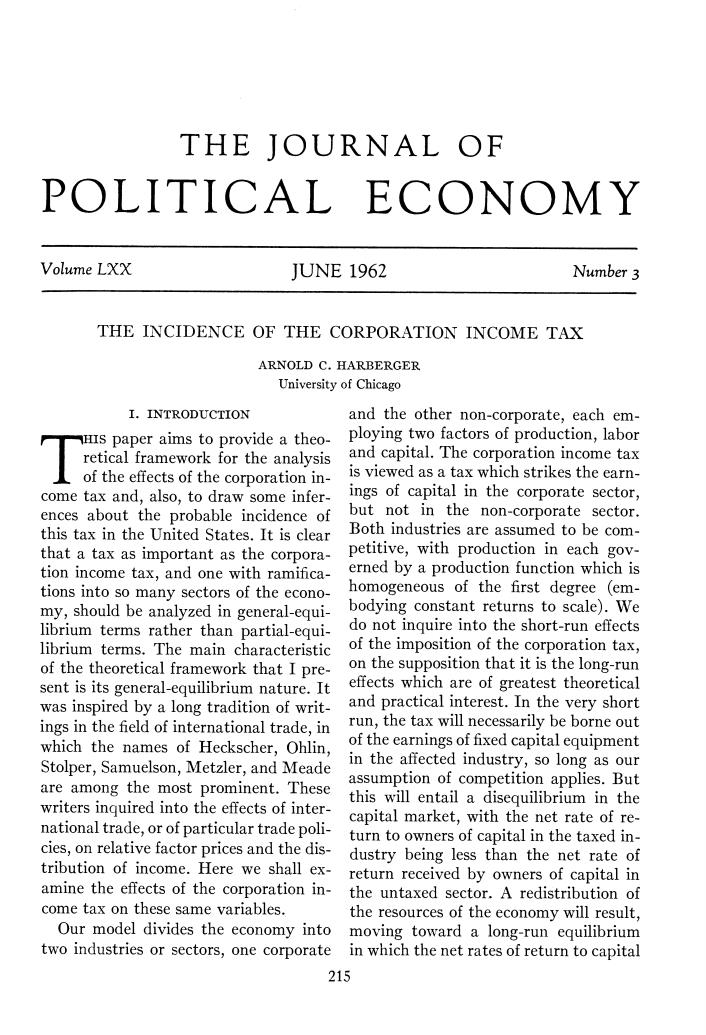
THE JOURNAL OF POLITICAL ECONOMY Volume LXX JUNE 1962 Number 3 THE INCIDENCE OF THE CORPORATION INCOME TAX I.INTRODUCTION and the other each em- s paper aims to provide a theo- retical framework for the analysis of the effects of the corporation in- is vic ome tax the strikesthe a come tax and,also,to draw some infer- ings of capital in but not in the no corporate Both industries are assumed to be c ramifica- homogeneous of the first degre (em in genera bodying constant returns to scale).We qu nan partial- do not inquire into the short-run effects of tham of the imposition of the corporation tax, retical e main aracter ramework ti on the supposition that it is the long-run effects which are of greatest theoretical was inspir ng traditi and practical interest.In the very short Ohlin, the earnings of fixed capital equipment son,Metzl r,and in the affected industry,so long as our are among the most prominent. competitio applies Bu writers inquired into the effects of inter. in the capita marke national trade,or of particular trade poli- ne cies,on relative factor prices and the dis- the net tribution of income.Here we shall ex- amine the effects of the corporation in- the A redis come tax on these same variables. the resour of the Our model divides the economy into my two industries or sectors,one corporate in which the net rates of return to capital 215
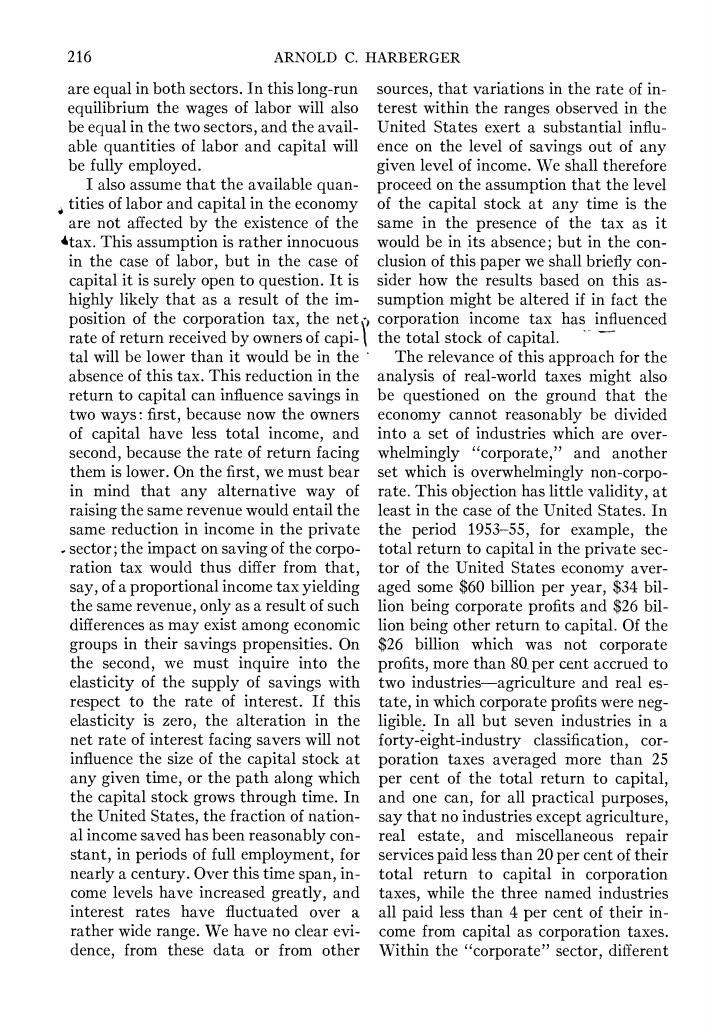
216 ARNOLD C HARBERGER are equal in both sectors.In this long-run sources.that variations in the rate of in- equilibrium the wages of labor will also terest within the ranges observed in the be equal in the two sectors,and the avail- United States exert a substantial influ able quantities of labor and capital will be fully employed ence the level of out of any given level of income. We shall therefore I also assume that the available quan proceed on the assumption that the level tities of labor and capital in the economy of the capital stock at any time is the are not affected by the existence of the same in the presence of the tax as it 4tax.This assumption is rather innocuous in the would be in its absence;but in the con of labor,but in the ca uso of this paper we shall briey con sider how the results based on this as. highly likely that as a result of the im- sumption might be altered if in fact the position of the corporation tax.the net corporation income tax has influenced rate of return received by owners of capi-l the total stock of capital. tal will be lower than it would be in the The relevance of this approach for r the abser ce of this tax This eduction in th analysis of real- world night also return to capital can influence savings in be questioned on the ground that the two ways:first,because now the owners economy cannot reasonably be divided of capital have less total income and into a set of industries which are over. second.because the rate of return facing whelmingly “corporate,.” and another them is lower.On the first must bear set which is ove on mind that any alterna e wa o Thi objection has lidity,at raising the same revenue would entail the least in the case of the United States. In same reduction in income in the private the period 1953-55,for example,the sector;the impact on saving of the corpo- total return to capital in the private sec- ration tax would thus differ from that. tor of the United States economy aver e tax yieldin ag me $60 billion pe yea $34 bil same revenue,only as a result of suc being corporate profits an differences as may exist among economic lion being other return to capital.Of the groups in their savings propensities.On $26 billion which was not corporate the second,we must inquire into the profits,more than 80 per cent accrued to elasticity of the supply of savings with two industries- agriculture and real es- rate of inter If this in which the In all porate pre were neg zero in ligibl but seven industries in a net rate of interest facing savers will not forty-eight-industry classification,cor infuence the size of the capital stock at poration taxes averaged more than 25 any given time or the path along which ber cent of the total return to capital the capital stock grows through time.In and one can,for all practical purp the United states the fraction o of nation- tha dustrie except agriculture alincome saved ha rea sonably real estate and miscellaneous stant,in periods of full employment,for services paid less than 20 per cent of their nearly a century.Over this time span.in- total return to capital in corporation come levels have increased greatly and taxes,while the three named industries interest rates have fluctuated over rather wide ran all paid less than 4 per cent of their in- nge.We have clea from capital corporation taxe dence,from these data or from other Within the “corporate'”sector,different
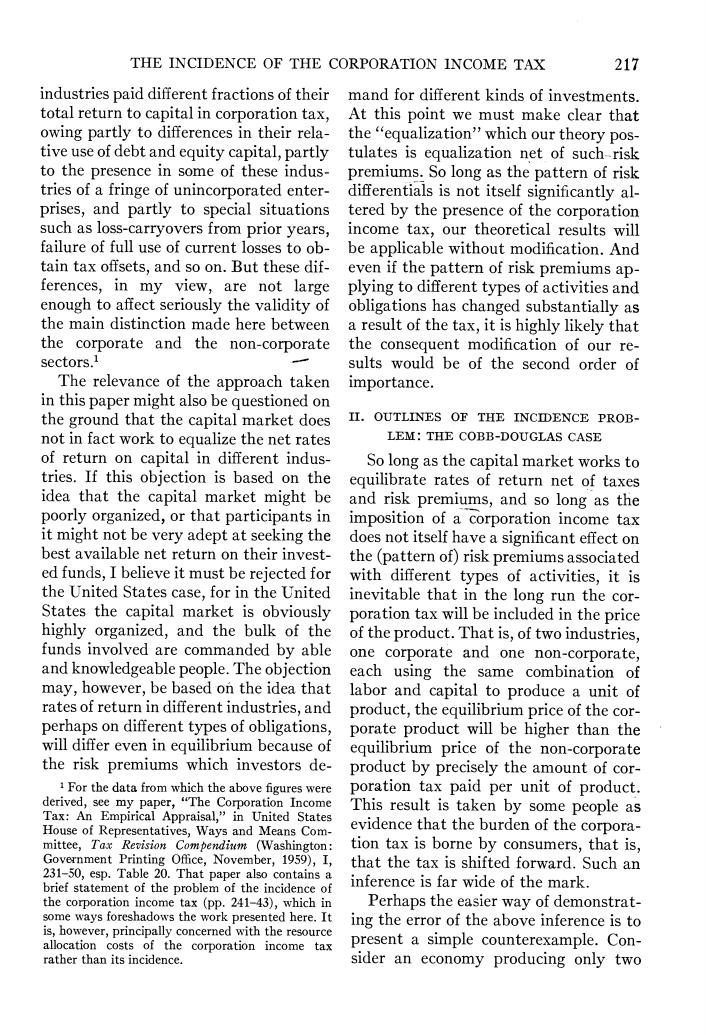
THE INCIDENCE OF THE CORPORATION INCOME TAX 217 industries paid different fractions of their mand for different kinds of in stments At this pointwe must make clear that the "equalization"which our theory pos. tive use of debt and equity capital,partly tulates is equalization net of such-risk to the presence in some of these indus- premiums.So long as the pattern of risk tries of a fringe of unincorporated enter- differentials is not itself significantly al- tered by the prese nce of the corporati uch as loss. rryovers Irom prior yea ncome failure of full use of crent ossestoob theoretical results will be applicable without modification.And tain tax offsets,and so on.But these dif- even if the pattern of risk premiums ap ferences.in my view. are not large plying to different types of activities and enough to affect seriously the validity of obligations has chand the main distinction made here betweer re ult of the tax,it is highly likely tha the orporate no t uent modincation of our re. sector and sults would be of the second order of The relevance of the approach taken importance. in this paper might also be questioned on the ground that the capital market does II.OUTLINES OF THE INCIDENCE PROB. not in fact work the net rates LEM:THE COBB-DOUGLAS CASE pital different inc So long as the capital market works to this objection is based on the equilibrate rates of return net of taxes idea that the capital market might be and risk premiums,and so long as the poorly organized,or that participants in it might not be very adept at seeking the imposition of a c orporatio in does not itself ave a significant effect on best available net rett on their i the(pattern of)risk premiums associated he United States case.for in the United rejected fo with different types of activities,it is inevitable that in the long run the cor- States the capital market is obviously highly organized,and the bulk of the poratiotax in the pric of the product.That is,of two industries funds involved are commanded by able one people. corporate and one non-corporate and knowledgeable The e using the same combination of may,h wever, be the idea that labor and capital to produce a unit of rates of return in different indu tres,and product,the equilibrium price of the cor perhaps on different types of obligations porate product will be higher than the will differ even in equilibrium because of m price of the the risk premiums which investors de- produ -corporate by prec ely the amount of cor poration tax paid per unit of product Tax:An United Stat This result is taken by some people as evidence that the burden of the corpora- / eans Com tion tax is bo rne by consumers,that is. Office,November,1959) that the tax is shifted forward.Such an rief statement of the problem ofthe nce is far wide of the mark. a(pp 241-43 whic Perhaps the easier way of demonstrat- concerned with the res ing the error of the above inference is to all ather thants the corporation income tax present a simple counterexample.Con- sider an economy producing only two
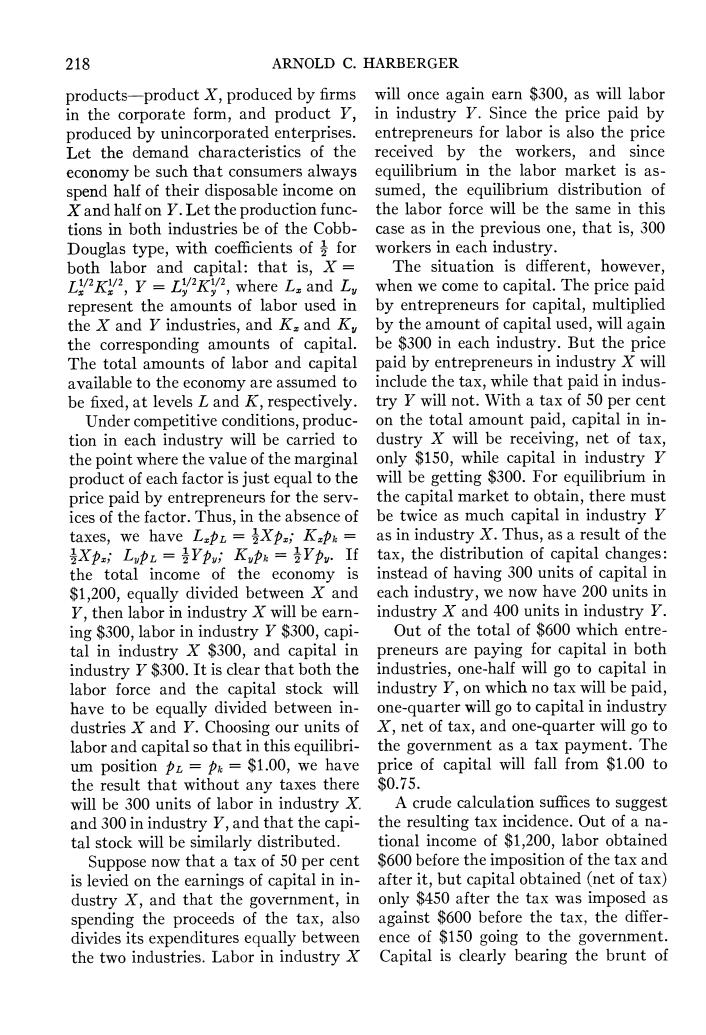
218 ARNOLD C.HARBERGER products-product X,produced by firms in the corporate form,and product Y, nroduced by unincorporated enterprises. entrepreneurs for labor is also the price Let the demand characteristics of the received by the workers.and since econ equilibrium in the labor market is as sposable income ed the equilibrium ction the labor orce will be the sam tions in both industries be of the Cobb case as in the previous one,that is,300 Douglas type,with coefficients of for workers in each industry. both labo and capital:that is, The situation is different,however where L.and L when we come to capital.The price paid represent ar of labo used in by entrepren eu rs fo capital ultiplie the X and y industries,and K=and K by the amount capital 入 ll again the corresponding amounts of capital be $300 in each industry.But the price The total amounts of labor and capital Daid by entrepreneurs in industry x wil available to the economy are assumed to include the tax,while that paid in indus- respectively Under cor mpe itive con ons,pr t the total am tion in each industry will be carried to dustry will yount in in rece of tax the point where the value of the marginal product of each factor is just equal to the will be getting s300.For eauilibrium in the capital market to obtain,there must s of the in the ab ce of be twice as much capital in industry V axes, we have as in indu as a ult of the tax,the distributior of capital changes the total income the economy 1 instead of having 300 units of capital in S1.200,equally divided between X and each industry,we now have 200 units in Y,then labor in industry X will be earn industry X and 400 units in industry Y. $300,labor in indus try Y $300. Out of the total of s600 which entre in industry $30 an rs are pay r capital in both industry Y $300.It is clear that both the industries,one- will go to pital labor force and the capital stock will industry y.on which no tax will be paid have to be equally divided between in- one-quarter will go to capital in industry dustries X and Y.Choosing our units of x.net of tax.and one-quarter will go to labor a nd c capital so that in this the vernment as a tax payment.The um position P5 =S1.00, we have pric of capital will fall $1.00to the result that without any taxes there 50.75. will be 300 units of labor in industry X A crude calculation suffices to suggest and 300 in industry Y,and that the capi- the resulting tax incidence.out of a na tal stock will be similarly distributed tional income of $1,200,labor obtained Suppose nov w that a tax of 50 nt $600 before the imposition of the tax and is levied on the earnings of capital inin- but capita btained (net of tax) dustry X,and that the government,in only $450 after the tax was impose spending the proceeds of the tax,also against $600 before the tax,the differ divides its expenditures equally between ence of S150 going to the government the two ind ries Labor in industry X Capital is clearly bearing the brunt of
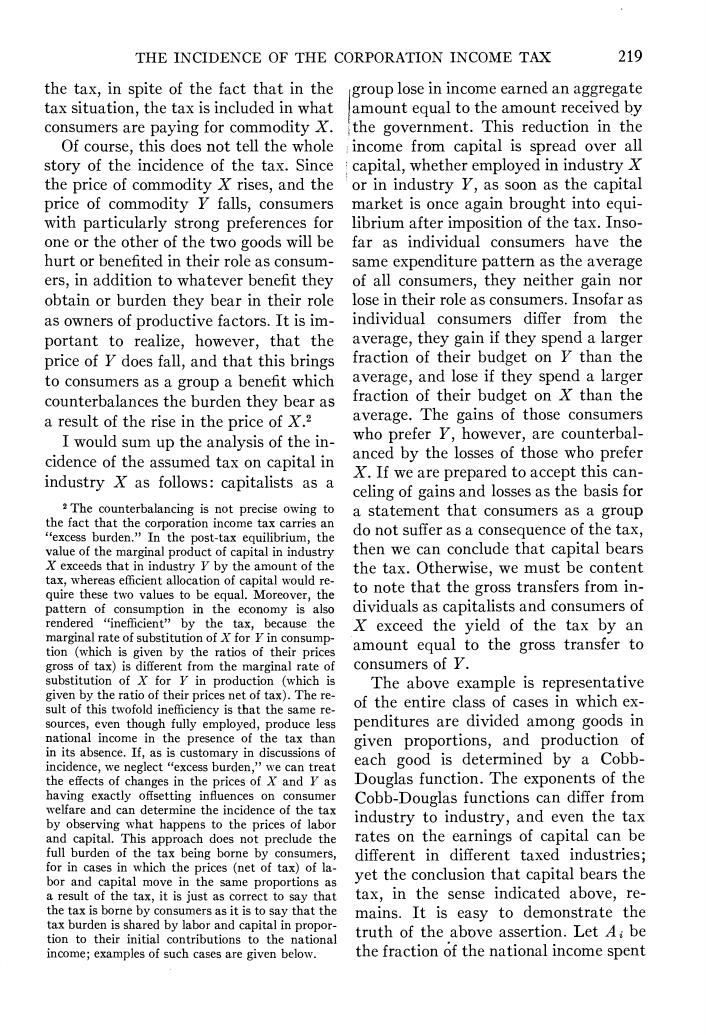
THE INCIDENCE OF THE CORPORATION INCOME TAX 219 the tax,in spite of the fact that in the group lose in income earned an aggregate tax situation.the tax is included in what amount equal to the amount received by consumers are paving for commodity x. the government.This reduction in the Of course,this does not tell the whole inco e from capital is spread over all of the incidence of the tax.Since apital,w employed in industryX of com X rises,and the or in industry Y,as s oon a the capita market is once again brought into equi with particularly strong preferences for librium after imposition of the tax.Inso- one or the other of the two goods will be far as individual consumers have the hurt or benefited in their role as consum- same expenditure pattern as the average ers,in addition to whatever be nefit they of all um ey neither gain no obtain or burden they bear in their role he e as con Insofar as owners of productive factors.It is im- individual consumers diffe Irom portant to realize,however,that the average,they gain if they spend a larger price of y does fall,and that this brings fraction of their budget on y than the to consumers as a group a benefit which ver and lose if they spend a larger counterbalances the burden they bear as fracti of their budge on X than t a result of the rise in the price of y average gains oft cons I would sum up the analysis of the in- who prefer Y,however,are counterbal anced by the losses of those who prefer cidence of the assumed tax on capital in industry X as follows:capitalists as X.If we are prepared to accept this can celing of gains and losses as the basis for The ounterbalancing is not r e owing to sta atement that consumers the fact that the group do not suffer as a consequence of the tax value of the duct of capital in industr then we can conclude that capital bears stry y by the am the tax.Otherwise.we must be content values to be to note that the gross transfers from in dividuals as capitalistsand consumers of exc ed the yield of the tax by an rate of sub mp amount equa to the gross transter to rent fr consumers of y. stitution of The above example is representative e re of the entire class of cases in which ex- penditures are divided among 0 given propo ts a tomary in discu and each good is determined by a C efrects of changes in the ices of x and Yas Douglas function.The exponents of the a ing exac of sum Cobb-Douglas functions can differ from g what happens to the prices industry to industry,and even the tax of the th s of capital can be or in cas taxe which the Pb ices (net of tax)of la. ent in yet the conclusion that capital bears th esult of the tax.it is just as correct to say tax,in the sense indicated above, re. the ta bore by the mains It is easy to demonstrate the tion to their initial contributions to the national truth of the above assertion.Let A:be of such cases are given belo the fra ction of the national income spent